 |
 |
 |
Our route:
07.12.02:
Svilengrad
Kavala
08.12.02:
Kavala
Philippi
Thessaloniki
09.12.02:
Thessaloniki
Pella
10.12.02:
Veria
Dion
11.12.02:
Ambelakia
12.12.02:
Meteora
13.12.02:
Lamia
14.12.02:
Itea
15.12.02:
Delphi
Osios Lukas
16.12.02:
Thiva / Theben
Brauron
17.12.02:
Sunion
18.12.02 - 23.12.02
Athens
24.12.02 - 07.01.03:
Netherlands
07.01.03:
Athens
Kiato
08.01.03 - 09.01.03:
Diakopto
10.01.03 - 12.01.03:
Kalavryta
13.01.03:
Kastria
14.01.03:
Olympia
Bassae
Andritsena
15.01.03:
Karitena
Mavromati
16.01.03:
Messini
Kalamata
17.01.03:
Mystras
18.01.03 - 21.01.03:
Kalamata
22.01.03:
Mani
23.01.03:
Gythio
Geraki
Leonidios
24.01.03:
Argos
25.01.03:
Nafplio
26.01.03:
Mycenae
ancient Corinth
27.01.03 - 30.01.03:
Acro-Corinth
Corinth
31.01.03 - 06.02.03:
Thermophyles
Lamia
07.02.03:
Larissa
08.02.03:
Vergina
09.02.03:
Pella
10.02.03 - 11.02.03:
Thessaloniki
12.02.03:
Kavala
Komotini
13.02.03 - 15.02.03:
Alexandroupoli
|
|
 |
| Greece |
 |
 |
 |
 |
 |
 |
On this page, we (will) describe our experiences in Greece.
Apart from the travelogue for this country
you will also find a number of links to useful sites,
ranging from general information to embassy homepages.
Written by: Dorrit
Northern-Greece: 06.12.02 - 18.12.02
Excluding the somewhat better roads (or rather, those that have been financed by the EU) I don't really see much difference between Greece and Bulgaria/Romania at first. Stray dogs and ditto cats are searching for food among the garbage (even old fridges and car wrecks can be seen) that lies around everywhere. Houses and factories seemingly haven't had any maintenance for over 30 years. The bad weather - heavy rain and stormy - makes it even more cheerless. But: according to the weather forecast there is heavy snow in Bulgaria and Romania now, so why complain!
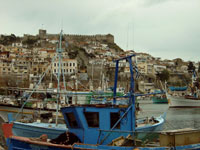 Just before Kavala (between Svilengrad and Thessaloniki) we were stopped for passport controls by border police armed with Uzi's. It is our first check since we left home in April! Kavala is a cute, typically Greek harbour town, with white houses lying picturesquely against the flanks of the mountain. Our first excavation in Greece was in the neighbouring Philippi, where the apostle Paul first set foot on European soil. In honour of this he built a cathedral, which ruins can still be seen, as well as those of the Roman market next to it. Historical ground, so to speak.
Just before Kavala (between Svilengrad and Thessaloniki) we were stopped for passport controls by border police armed with Uzi's. It is our first check since we left home in April! Kavala is a cute, typically Greek harbour town, with white houses lying picturesquely against the flanks of the mountain. Our first excavation in Greece was in the neighbouring Philippi, where the apostle Paul first set foot on European soil. In honour of this he built a cathedral, which ruins can still be seen, as well as those of the Roman market next to it. Historical ground, so to speak.
Thessaloniki (named after the sister of Alexander the Great) is the second largest city of Greece after Athens. It was already the second largest city in the Byzantine empire, after Byzantium / Constantinoupoli (Istanbul).
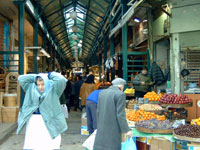
Consequently, the city is loaded with historical monuments: Roman arches of triumph and thermal baths, Byzantine churches and monasteries as well as Turkish mosque-ruins. This part of Greece has been Turkish for over 500 years, until 1912, and its influence can still be felt. The bazaar is a real must, an indoor market place where you can really get anything you want, up to skinned pig and sheep heads.
Via the birth house of Mustafa Kemal Pasha Ataturk, the "father of the Turks" and founder of the Turkish republic, we walked to the biggest church of Greece, the Agios Dimitrios. The church itself was not really special, but the Roman baths they found in the basement of the church - still in perfect condition - are!
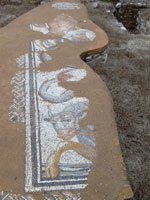 In Pella, the birth place of Alexander the Great, there were some houses dating from the 4th century BC that we wanted to visit for their excellent mosaics. To our terror there was an entrance fee of EUR 6 p.p. for it. As if they had glued the mosaics themselves! We skipped this sight and drove on to Veria, where the Macedonian king Philipp II (the father of Alexander the Great) was buried in a richly decorated mausoleum. Here as well, the entrance fee of EUR 8 p.p. was somewhat above our budget, so we drove on to the next sight in Dion. This way we go through the sights of Greece with amazing speed. In Dion however, it turned out that all sights in Greece are free for EU-students and on Sundays for all other EU citizens as well. Good thing we carry our (in 1995 expired but still nearly everywhere accepted) student cards :o)
In Pella, the birth place of Alexander the Great, there were some houses dating from the 4th century BC that we wanted to visit for their excellent mosaics. To our terror there was an entrance fee of EUR 6 p.p. for it. As if they had glued the mosaics themselves! We skipped this sight and drove on to Veria, where the Macedonian king Philipp II (the father of Alexander the Great) was buried in a richly decorated mausoleum. Here as well, the entrance fee of EUR 8 p.p. was somewhat above our budget, so we drove on to the next sight in Dion. This way we go through the sights of Greece with amazing speed. In Dion however, it turned out that all sights in Greece are free for EU-students and on Sundays for all other EU citizens as well. Good thing we carry our (in 1995 expired but still nearly everywhere accepted) student cards :o)
Dion's temple and city ruins (dating from ca 350 BC) were flooded last week and were still partly covered with water and a thick layer of mud. What a pity. It was nevertheless an impressive sight, with its beautiful statues and mosaics dominated by the Olympus mountain in the background.
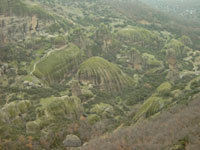 Through the beautiful Tempe canyon we drove to Meteora. Meteora you must have seen to believe it. The mountains look very different from the usual sharp ridged mountains: they are smooth and rounded, as if they were made of hardened lava. The mosses mainly grow on top and in stripes along the sides of the rocks, which makes some rocks look like giant ice cream balls poured over with chocolate sauce, but then gray with green.
Through the beautiful Tempe canyon we drove to Meteora. Meteora you must have seen to believe it. The mountains look very different from the usual sharp ridged mountains: they are smooth and rounded, as if they were made of hardened lava. The mosses mainly grow on top and in stripes along the sides of the rocks, which makes some rocks look like giant ice cream balls poured over with chocolate sauce, but then gray with green.
Some rocks stand separately from the massif as needles, all bald but for the top, so that they look like long, narrow heads with a little bit of hair on their crown.
In the 14th century monks have built monasteries and convents on the tops of some of these "rock needles", that cover the whole of the needle top. On each side, the walls of the rock seem to continue into the walls of the monastery seamlessly, it seems as if the cloister has grown out of the rock needle. Back then you could only reach the cloisters if the monks or nuns would haul you up in a net, but nowadays there is an asphalt road passing all the cloisters and there are staircases along the side of the rocks so that tourists can access the cloisters as well.
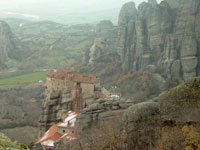 We thought we might as well start visiting the highest, biggest and best monastery of all, the 1360 built Megalo Meteora (megalo = big, meteora = in the air). I had to put on a skirt, since women in trousers are not allowed in. Inside among others loads of fresco's of martyrs, a 16th century dining hall and a skull room, where skulls were neatly lying next to each other on little shelves.
We thought we might as well start visiting the highest, biggest and best monastery of all, the 1360 built Megalo Meteora (megalo = big, meteora = in the air). I had to put on a skirt, since women in trousers are not allowed in. Inside among others loads of fresco's of martyrs, a 16th century dining hall and a skull room, where skulls were neatly lying next to each other on little shelves.
Through the marvellous surroundings we walked to the other cloisters (Varlaam, Roussanou and Agio Stephano) and admired the daring construction of the cloisters. We finished our tour of Meteora by viewing mount Dupiani, a kind of Emmenthal cheese full of holes in which hermit monks have been living since as early as the 9th century. In one of the holes a bit further away from the road a hut was built, in which a whole gipsy family was living.
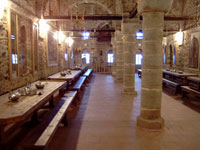 We spent Coen's birthday (14.12) relaxing in a coastal village near Delphi, where we drank excellent cappuccino's in the Greek kafenions; enormous bars full of old men (not a single woman to be found) who spend their whole day there playing card or backgammon and drink maybe one coffee all day, consumption not obligatory! We had long walks along the pebble beaches and a nice evening dining out.
We spent Coen's birthday (14.12) relaxing in a coastal village near Delphi, where we drank excellent cappuccino's in the Greek kafenions; enormous bars full of old men (not a single woman to be found) who spend their whole day there playing card or backgammon and drink maybe one coffee all day, consumption not obligatory! We had long walks along the pebble beaches and a nice evening dining out.
On Sunday however, we had a full programme: we had to get up really early to see Delphi, because you need at least 3 hours for that and we wanted to be there before the masses arrived. The temple complex dating from the 6th century BC was situated superbly in a sort of natural amphitheatre; 3 sides were walled in by the mountains, the front was looking out over the whole valley below.
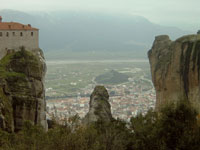 The centre was built by the rests of the huge Apollo-temple where the famous Delphi oracle was, around it the ruins of the treasure rooms where the sacrifices were kept, an amphitheatre and a stadium. It must have been splendid once, but there is so little left that you need a lot of fantasy to imagine it. The museum was plainly disappointing. Half of it was closed for renovation, the other half was hardly worth the while, excepting some larger statues. On our way out we were met by some 100 school kids who just came out of their touring cars to see Delphi. Good thing we were early!
The centre was built by the rests of the huge Apollo-temple where the famous Delphi oracle was, around it the ruins of the treasure rooms where the sacrifices were kept, an amphitheatre and a stadium. It must have been splendid once, but there is so little left that you need a lot of fantasy to imagine it. The museum was plainly disappointing. Half of it was closed for renovation, the other half was hardly worth the while, excepting some larger statues. On our way out we were met by some 100 school kids who just came out of their touring cars to see Delphi. Good thing we were early!
After a much earned breakfast we moved on to the secluded monastery Osios Lukas, that offers besides a splendid view over the mountain area some of the finest gold-rimmed mosaics of Greece. Instead of fresco's, the whole of the inside walls of the church are covered with these mosaics.
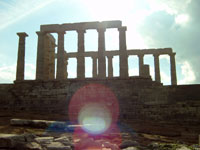 Before going to Athens we first wanted to see some excavations in the area east of Athens (Attica). Unfortunately they seem to have limited opening hours off-season meaning a number of sights were closed when we arrived there. The Attica area is somewhat greener than the north of Greece and there are some nice nature areas. However, these are usually so polluted that it makes one depressive. Sometimes you suddenly see a heap of garbage on the slopes below the road, as if after e.g. renovating their bathroom people drive their waste in a tip up truck to a nature area and dump the whole lot in one time down the hill. A very depressing sight.
Before going to Athens we first wanted to see some excavations in the area east of Athens (Attica). Unfortunately they seem to have limited opening hours off-season meaning a number of sights were closed when we arrived there. The Attica area is somewhat greener than the north of Greece and there are some nice nature areas. However, these are usually so polluted that it makes one depressive. Sometimes you suddenly see a heap of garbage on the slopes below the road, as if after e.g. renovating their bathroom people drive their waste in a tip up truck to a nature area and dump the whole lot in one time down the hill. A very depressing sight.
On the southernmost point of Attica, southeast of Athens near Sunion, lies the Poseidon temple dramatically on a steep cliff that reaches out far into the sea. A beautiful spot to just sit and relax a little in the sun.
Athens: 18.12.02 - 07.01.03
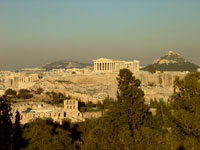 Athens. What an amazing chaos! Everyone seems to be tired of life here. Cars make a full-stop or turn left and right without indicating, come racing out of small side roads and throw themselves before your car as if the drivers were immortal. Not to mention the masses of scooters which pass you left and right with 80 km/h on a four-lane road and switch lanes without even pretending to look first. Helmets are nowhere to be seen, of course. Most of the scooters are overloaded, some even with propane gas bottles. Moving gas bombes so to speak. Once in the centre of Athens you may be glad if you are moving at all; the narrow streets are totally blocked up by double parked cars and unloading vans and trucks. The people of Athens are extremely impatient and are honking non stop at everything and everyone. Once we even saw how a number of people got out of their cars, lifted and carried a double parked car off and dumped it somewhere out of the way.
Athens. What an amazing chaos! Everyone seems to be tired of life here. Cars make a full-stop or turn left and right without indicating, come racing out of small side roads and throw themselves before your car as if the drivers were immortal. Not to mention the masses of scooters which pass you left and right with 80 km/h on a four-lane road and switch lanes without even pretending to look first. Helmets are nowhere to be seen, of course. Most of the scooters are overloaded, some even with propane gas bottles. Moving gas bombes so to speak. Once in the centre of Athens you may be glad if you are moving at all; the narrow streets are totally blocked up by double parked cars and unloading vans and trucks. The people of Athens are extremely impatient and are honking non stop at everything and everyone. Once we even saw how a number of people got out of their cars, lifted and carried a double parked car off and dumped it somewhere out of the way.
In the travel guide I read that Athens had only 8000 inhabitants until some 200 years ago. The current 5 million inhabitants (! half of the total Greek population!) have thus moved here in a relatively short period and the city had to be built up quickly. That this was done in a rather unplanned way is shown by the many narrow streets that are just a bit too small for the current traffic volume and by the everlasting smog cloud hanging over the whole city.
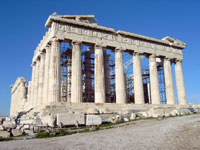 I am glad we are here in winter and not in summer when it is 35°C.
I am glad we are here in winter and not in summer when it is 35°C.
The sights of Athens can be seen in a day or two, but since we have time until December 23rd we take our time. Rambled aimlessly through the medieval Plaka-area a bit, seen the Roman market and ditto temple Olympieion and viewed the 3000 years old village of Kerameikos. The weather is very unstable, one day it is sunny and 18°C and the next it is snowing (we even saw snow on the Acropolis) and it gets no warmer than 3°C. On the warm days it is very strange to see the Christmas decorations in the city centre, you would nearly forget it is the end of December.
We saved the Acropolis until Sunday, since we expect that they will look a bit closer at our student cards here and since we have time to wait anyway. The Acropolis was actually quite disappointing, it was being renovated and was half in scaffolding. The Greek want to polish up all excavations in Greece for the Olympic Games in 2004 in Athens, with the result that most of them are under construction and nearly all museums are closed until April 2004. If you plan to visit Greece, it might be better to postpone this until after the Games.
At night we concluded our first half of Greece at the Thanasis terrace (see tips), where we had a cheap but lovely souvlaki, and went to bed early as we had to get up at 5:30 to catch our plane to Holland on the next day.
After a 3 hour flight we arrived in the cold and wet (what else) Holland, where we were pampered by our family for two whole weeks. With many thanks to our parents, who sponsored this trip!
We were only just in time for our flight back (it had been snowing so Holland was turned into one big traffic jam), but only because the flight itself was delayed too. That night we had another delicious souvlaki at Thanasis, as if we hadn't been away at all...
Peloponnese: 07.01.03 - 30.01.03
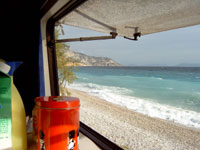 The guys in the parking garage, where we had left the van during the last 3 weeks, gave us a Maria-amulet and an "evil-eye-catcher" - a small glass eye - to ward off danger. Maria was supposed to protect us against the Greek traffic and the eye was to fend off curses and evil will. Thus guarded we indeed managed to escape from the Athens traffic unharmed and drove south. We had breakfast with a view to a blue sky, a turquoise sea and a white pebble beach, isn't this the ultimate holiday!
The guys in the parking garage, where we had left the van during the last 3 weeks, gave us a Maria-amulet and an "evil-eye-catcher" - a small glass eye - to ward off danger. Maria was supposed to protect us against the Greek traffic and the eye was to fend off curses and evil will. Thus guarded we indeed managed to escape from the Athens traffic unharmed and drove south. We had breakfast with a view to a blue sky, a turquoise sea and a white pebble beach, isn't this the ultimate holiday!
We decide to seize this thought and relax at the coast for a few days before we go on with our sightseeing-tour. Coen finally managed to write the Romania travelogue and I wrote a few lines about our thoroughfare through Bulgaria. All in all some 2 days work again.
We left the coast and drove through the mountains to Kalavryta. The landscape reminded us a bit of Meteora: smooth and round rocks in all kind of funny shapes. Here as well a cloister (Mega Spileo) in the mountains, this time glued to the side of a vertically rising rock wall. It is marvellously situated, but the monastery itself has been renovated and extended rather badly in the 70s and is hardly an asset to its surroundings anymore.
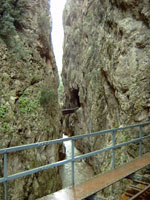 According to our travel guide you can make fantastic walks here, so we set out looking for information in Kalavryta, the centre of this area. No tourist info, the library has only one brochure in Greek and without map and the ski-info did not have any information either. In the ski rental shop they told us that the police had English brochures about the area. Seemed a bit strange, but who knows. At the police office they did not have any information of course, but they told us that we could find brochures and information in... the ski rental shop. Right...
According to our travel guide you can make fantastic walks here, so we set out looking for information in Kalavryta, the centre of this area. No tourist info, the library has only one brochure in Greek and without map and the ski-info did not have any information either. In the ski rental shop they told us that the police had English brochures about the area. Seemed a bit strange, but who knows. At the police office they did not have any information of course, but they told us that we could find brochures and information in... the ski rental shop. Right...
In the end we did manage to find someone who knew a bit more and found a good route for the next day.
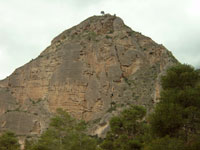 Indeed a great route through the breathtaking Vouraikos-canyon (Norway calibre!).
There was no other way than a one-track railway, where a little tourist train passed three times a day. This we followed through the canyon, in a three hour sweat uphill. But absolutely worth the while. Splendid steep rock walls of which erosion had "eaten" parts of the upper layer. What was left looked like huge hieroglyphs on an enormous stone tablet. In the holes at the bottom of the mountains were makeshift huts with sheep herds between them. At some points the ravine became very narrow and steep, so that there was only just enough space for the wildly foaming river and the small railway. Wow!
Indeed a great route through the breathtaking Vouraikos-canyon (Norway calibre!).
There was no other way than a one-track railway, where a little tourist train passed three times a day. This we followed through the canyon, in a three hour sweat uphill. But absolutely worth the while. Splendid steep rock walls of which erosion had "eaten" parts of the upper layer. What was left looked like huge hieroglyphs on an enormous stone tablet. In the holes at the bottom of the mountains were makeshift huts with sheep herds between them. At some points the ravine became very narrow and steep, so that there was only just enough space for the wildly foaming river and the small railway. Wow!
Through the inner parts of the Peloponnese, where the farmers still wear traditional clothes and ride on olive branch-laden little donkeys from one village to the other we drove to Olympia, the birth place of the Olympic Games. The road to it was in a state that would make the Bulgarian and Romanian governments blush: along the "outside" of the mountain road whole pieces of the asphalt had broken off and fallen down the mountain slope. You had to swerve to the lane of the oncoming traffic to prevent ending at the bottom of the mountain.
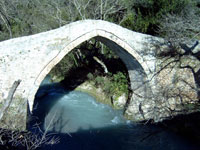 The museum in Olympia was - we hardly expected any differently anymore - closed until April 2004, but the excavation itself was open. The training rooms of the athletes really appealed to the imagination. So did the stadium, where the marble starting lines and the entrance tunnel for the athletes are still there.
The museum in Olympia was - we hardly expected any differently anymore - closed until April 2004, but the excavation itself was open. The training rooms of the athletes really appealed to the imagination. So did the stadium, where the marble starting lines and the entrance tunnel for the athletes are still there.
Between Olympia and Messini we wanted to include a walking day in Karitena, near the Alfios and Loussio ravines. From the castle on top of the hill in Karitena you had a splendid view over the ravines and the green valleys around it. You couldn't really walk through the ravines like in Kalavryta, but we could follow a nice route through the mountains instead.
The excavations of the ancient Messini is not in the town of Messini, but 25 km north of it in Mavromati. The city was built in 400 BC to defend the area against the aggressive Spartans and was guarded by a 9 km long wall, of which parts still stand. The excavation seems rather new, they are at least still digging everywhere.
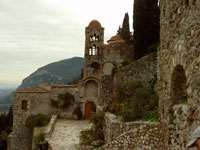 Before leaving for the south coast of the Peloponnese (the Mani area), we wanted to squeeze in the 13th century Byzantine city ruins Mystras near Sparta.
Before leaving for the south coast of the Peloponnese (the Mani area), we wanted to squeeze in the 13th century Byzantine city ruins Mystras near Sparta.
The journey there from Kalamata, through the Langada ravine, is really fantastic. This ravine is like the bigger version of the Vouraikos canyon near Kalavryta.
At the end of this canyon lies a lonesome mountain, on which the ruined city of Mystras was built.
Like a fairytale town Mystras spirals its way up along the sides of the mountain, its top crowned by the city castle and its walls.
Directly below the castle lies the "upper town" with the first city wall and below that comes the "lower town" with the second city wall.
The Byzantine cloisters and churches are the only ones that have survived more or less intact and are even partly inhabited. The rest of this ghost town exists of ruins, that are gradually being covered in weeds.
In Kalamata we found a camping and have worked on the car and the website for a couple of days.The Mani-area in the south of the Peloponnese should be one of the most beautiful parts of Greece, but because of the heavy rainfall we hardly saw anything of the no doubt stunning landscape. According to the Greeks we met this is one of the worst winters ever in Greece. Thanks, we feel a lot better now. After a full week of rain, rain and more rain we agree not to drive on to the south but to turn around and start our way back north to Istanbul. The drive to the north-east of the Peloponnese, through the Parnos mountains and the Dafnos ravine via the typically Greek villages Geraki and Leonidios was truly magnificent. At the east coast we were rewarded with a breathtaking view over the sea, the green bays and the white sandy beaches.
The little harbour town of Nafplio must be really charming in summertime,
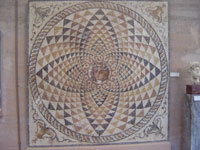 for us it was mainly a wet experience with the heavy rain pouring down non-stop.
The same could be said about Mycenae; a bizarre, completely preserved grave hill from the 20th century - before Christ! We tried to climb the Acropolis that went with it, but were nearly washed away by the rain and storm. But since it was Sunday we did not give up and went on to visit ancient Corinth. A nice excavation of the old market square and surrounding shops. Some still contained marble tills. The museum was (hurray) open and very nice, with its enormous statues and marvellous mosaics. The Acro-Corinth; the fortress of ancient Corinth on the mountain is still well preserved and nice to walk through.
for us it was mainly a wet experience with the heavy rain pouring down non-stop.
The same could be said about Mycenae; a bizarre, completely preserved grave hill from the 20th century - before Christ! We tried to climb the Acropolis that went with it, but were nearly washed away by the rain and storm. But since it was Sunday we did not give up and went on to visit ancient Corinth. A nice excavation of the old market square and surrounding shops. Some still contained marble tills. The museum was (hurray) open and very nice, with its enormous statues and marvellous mosaics. The Acro-Corinth; the fortress of ancient Corinth on the mountain is still well preserved and nice to walk through.
On our way to Istanbul: 31.01.03. - 15.02.03
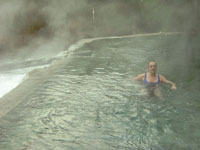 The advantage of driving back the same way you came is that you can still do those things you have not done the first time. And this we did: this time we did find the thermal baths near Lamia called "Thermophyles". The thermal baths were closed, but if you follow the river of hot, smelly (sulphite) water behind it into the mountains you will find the spring itself - the very one in which Leonidas bathed before he was killed by the Persians. Originally, it was behind a fence, but some non-conformist Greek must have cut a big hole in this fence with the result that it is now "open" to the public.
A whole week we spent - together with a couple from Austria that was also travelling with their camper - lying in the 40°C hot thermal spring. When the water temperature is that high it does not seem to matter so much that the air temperature is only 5°C and that it is raining all day. "Lying in the "pool" before breakfast, having breakfast, lying in the pool during the afternoon, having tea and dinner and finally having a bath at night by romantic oil lamp light" defines our daily program pretty well. Just great!
The advantage of driving back the same way you came is that you can still do those things you have not done the first time. And this we did: this time we did find the thermal baths near Lamia called "Thermophyles". The thermal baths were closed, but if you follow the river of hot, smelly (sulphite) water behind it into the mountains you will find the spring itself - the very one in which Leonidas bathed before he was killed by the Persians. Originally, it was behind a fence, but some non-conformist Greek must have cut a big hole in this fence with the result that it is now "open" to the public.
A whole week we spent - together with a couple from Austria that was also travelling with their camper - lying in the 40°C hot thermal spring. When the water temperature is that high it does not seem to matter so much that the air temperature is only 5°C and that it is raining all day. "Lying in the "pool" before breakfast, having breakfast, lying in the pool during the afternoon, having tea and dinner and finally having a bath at night by romantic oil lamp light" defines our daily program pretty well. Just great!
Other things we managed to do after all were a splendid route along the western slopes of the Olympus mountains, now fully covered in snow, our visit to the tomb of king Philip II of Macedonia in Vergina (near Veria) and our visit to the mosaics of Pella, the city where Alexander the Great was born and which was at his time the capital of the Macedonian empire. Especially the (tiny) museum of Pella was worth our while, I am glad we got to see it after all.
In Thessaloniki and Kavala we did some final groceries before driving through the north-east of Greece to the Turkish border. It stopped raining, it is now freezing and an ice-cold wind is blowing very hard. We are more than ready for spring time!
Dorrit
|
 |
|
 |
 |
 |
 |
Our top 3: |
 |
 |
1. Meteora
2. Vouraikos ravine
3. Thermophyles
|
 |
 |
 |
 |
 |
 |
 |
 |
TIP |
 |
 |
The best souvlaki of Athens:
"Thanasis"
Mitropoleos / Plateia Monastirakiou
Monastiraki
Athene
|
 |
 |
 |
 |
 |
 |
 |
 |
TIP |
 |
 |
Did you know that all sights in Greece have free entrance for EU students?
Or that all EU citizens can enter for free on Sundays?
|
 |
 |
 |
 |
 |
 |
 |
 |
TIP |
 |
 |
Due to restaurations for the Olympic Games in Athens, nearly all musea are closed until April 2004!
|
 |
 |
 |
 |
 |
 |
|


